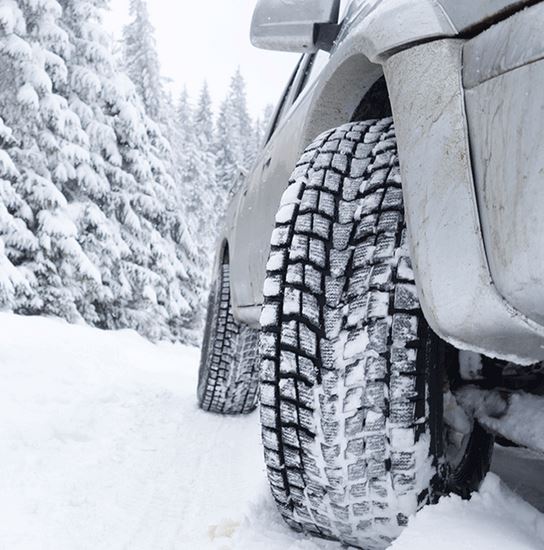Are you ready for the Surprises of winter driving?
Tips to prepare your vehicle for hazardous roads before winter arrives.

Ice storms are most common when the air temperature is close to freezing and blizzards become more likely as temperatures fall below freezing. Both can reduce visibility and create slippery road conditions that require enhanced vigilance and safe driving practices.
Whether freezing rain, sleet, snow or ice, the best time to prepare your vehicle for slick and hazardous roads is before winter arrives. Here are some recommendations to get your vehicle ready for severe weather and be prepared for winter driving.
And by the way – AMSOIL’s 100% synthetics are a major load off or your starter and charging system. Below 30 degrees you can easily hear the starting load difference between different oil brands and AMSOIL. We get that feedback all the time.
Prep your vehicle
- Battery – Cold temperatures are a battery killer. Check the battery voltage to ensure it has enough juice for cold starts and recharge it or replace it if not. Clean any corrosion from the battery terminals and verify the alternator is operating properly and belts are in good shape.
- Antifreeze – Verify existing antifreeze will provide subzero protection with a simple test available at any auto parts store. If it’s been several years since the antifreeze has been changed or there’s sludge or slime in your radiator, have it flushed and refilled.
- Wipers – Wiper blades are cheap insurance that you’ll be able to see in stormy weather, so replacing them before the winter is always smart. Fill the washer reservoir with a quality freeze-resistant fluid.
- Brakes – Stopping safely is more difficult on slick roads. If the brakes seem soft, noisy or unresponsive, have the brake fluid, pads, rotors and lines checked. Snow and ice from your boots can also accumulate on the floor mat restricting the pedals, so check the mat regularly.
- Fuel – Maintaining at least a half tank of fuel allows you to use the cabin heater to stay warm if you become stranded. It also helps prevent condensation moisture from collecting in the tank. Diesel fuel can gel in extreme cold, so put some AMSOIL Diesel Cold Flow in the tank.
- Tires – Tires should be inspected monthly for damage, wear and proper inflation, regardless of the season. Don’t forget to check the spare tire, too. Keep a pressure gauge in the vehicle as part of the tire service kit. There are more tips on snow tires below.
Emergency Kit
Many drivers fail to keep an emergency kit in their vehicle. Cell phones may speed up recovery time when stranded, but the batteries can die, and service isn’t always available, especially in remote areas and during violent winter storms.
- Flashlight – While traditional flashlights work well, they are of no use if the batteries are dead. LED flashlights last much longer, are usually rechargeable, and often feature an emergency strobe. In a pinch, your cell phone can also be used as a flashlight, after you’ve called for assistance.
- Batteries – Your electronics are worthless in an emergency if they don’t power on. Invest in a modern automotive emergency battery pack that includes a flashlight, strobe light, phone charger and can jump-start your vehicle! Keep it charged.
- Jumper cables – Quality, long, thick cables with multi-strand wire and heavy-duty clips will often save the day. Invest in four-gauge, 20-foot cables that won’t break the bank and will last a long time.
- Tool kit – Keep basic tools in the car, including a multi-tool, vise grips, pliers, screwdrivers, duct tape, zip ties and a tire-plug kit with CO2 inflater. A jack and tire iron should already be stored in your vehicle, so read the manual and understand how to use them to quickly change a flat in an emergency.
- Blanket – It’s often safest to remain in place and wait for help. A blanket can block the wind, contain body heat and keep you from freezing. Keeping a spare winter jacket, gloves, hat, boots and thermal undergarments in the car is even better if you’re prone to underdress, especially if you need to exit the vehicle.
- Energy Bars; Water – Keep a stash of non-perishable, high-energy foods such as granola bars and nuts in the car. It’s recommended to keep one gallon of drinking water per person per day on hand, but you can melt snow for drinking in winter, so you may only need a water bottle and some heat.
- First-aid kit – An Emergency First Aid guide or training will inform you the goal is to stop bleeding and prevent infection with absorbent gauze dressings and bandages, antibiotic ointment, antiseptic wipes, hydrocortisone and aspirin. Tools should include an emergency blanket, nonlatex gloves, adhesive cloth tape, a thermometer, compress, tweezers, and scissors. Premade kits are widely available for purchase, so you don’t have to buy everything individually.
- Medication – If you have any medical necessities, do not risk being stranded without them. Also keep an up to date “In Case of Emergency” (ICE) card with personal contacts, allergies and medications in both your wallet and phone, in case you are found unconscious.
- Other items to consider – A small shovel, an ice scraper and flares, which double as a Firestarter, are also excellent items to keep in your vehicle.
Driving in Snow
The best winter driving tip is don’t drive at all – stay put and wait it out. When snow starts falling, toss a log on the fire and relax. If you must drive in snow or ice, here are a few tips to stay out of the ditch.
- SLOW DOWN – It seems obvious, but speed increases the risk of losing control and the resultant damage. Leave earlier than normal, drive slowly and maintain ample distance between yourself and vehicles around you. Driving in first or second gear will also drastically limit speed and prevent the vehicle from gaining or losing momentum rapidly.
- Cruise Control – Never use it on wet/frozen surfaces. If you vehicle looses traction the quick ability to decelerate can cause your vehicle to go out of control.
- Acceleration – It’s fun to mash the gas and spin tires in the snow, but practice this driving skill in a large, empty, snow-covered parking lot. On the road, accelerate and brake smoothly and slowly to avoid spinning the tires.
- Braking – In slippery conditions, braking may result in zero friction between your tires and the road, causing a loss of steering and sliding instead of stopping. One way to avoid sliding before stops is to take your foot off the gas early and let the vehicle gradually lose momentum. Stoplights will often turn green before you need to touch the brake pedal. Driving in a lower gear also helps by forcing the engine to slow the car when you stop accelerating.
- Skidding – It takes experience to safely correct a skid. If your vehicle begins to slide, let off the gas, avoid the brakes and steer into the skid while allowing the vehicle to slow on its own. Now go back to practicing in a large, empty, snow-covered parking lot.
- Four-Wheel Drive – It’s no surprise that most folks in cold climates will only buy vehicles for winter use that are all-wheel drive (AWD) or four-wheel drive (4X4). Having four wheels driving your vehicle effectively doubles your traction and recovery ability compared to a two-wheel drive.
- Chains – In mountainous regions, it is mandatory to carry tire chains in high elevation areas and to install them when weather turns sour. Some places also allow studded tires, but both chains and studs do heavy damage to road surfaces, so only install them where legal or required.
- Snow Tires – The smartest buy! The initial cost of snow tires can be significant, but you won’t use them year-round, so they don’t wear as fast. You may get five seasons of use from a set. Snow tires are designed to stay soft and flexible when cold, for better traction and control, and they have a deeper tread design that reroutes snow and slush out of the treads, keeping water and ice from building up. The treads also have biting edges with many slits to provide extra grip on slick roads. There is no downside to snow tires except storing them but when you have them you sure are glad!
Driving during any winter storm is risky, if not dangerous. Winter storms, severe weather and slick road conditions are a factor in 500,000 crashes and more than 2,000 road deaths every winter, according to AAA.
Stay safe by preparing your vehicle for winter and preparing yourself with the right driving skills and the right tools and knowledge in case of a cold-weather emergency.








